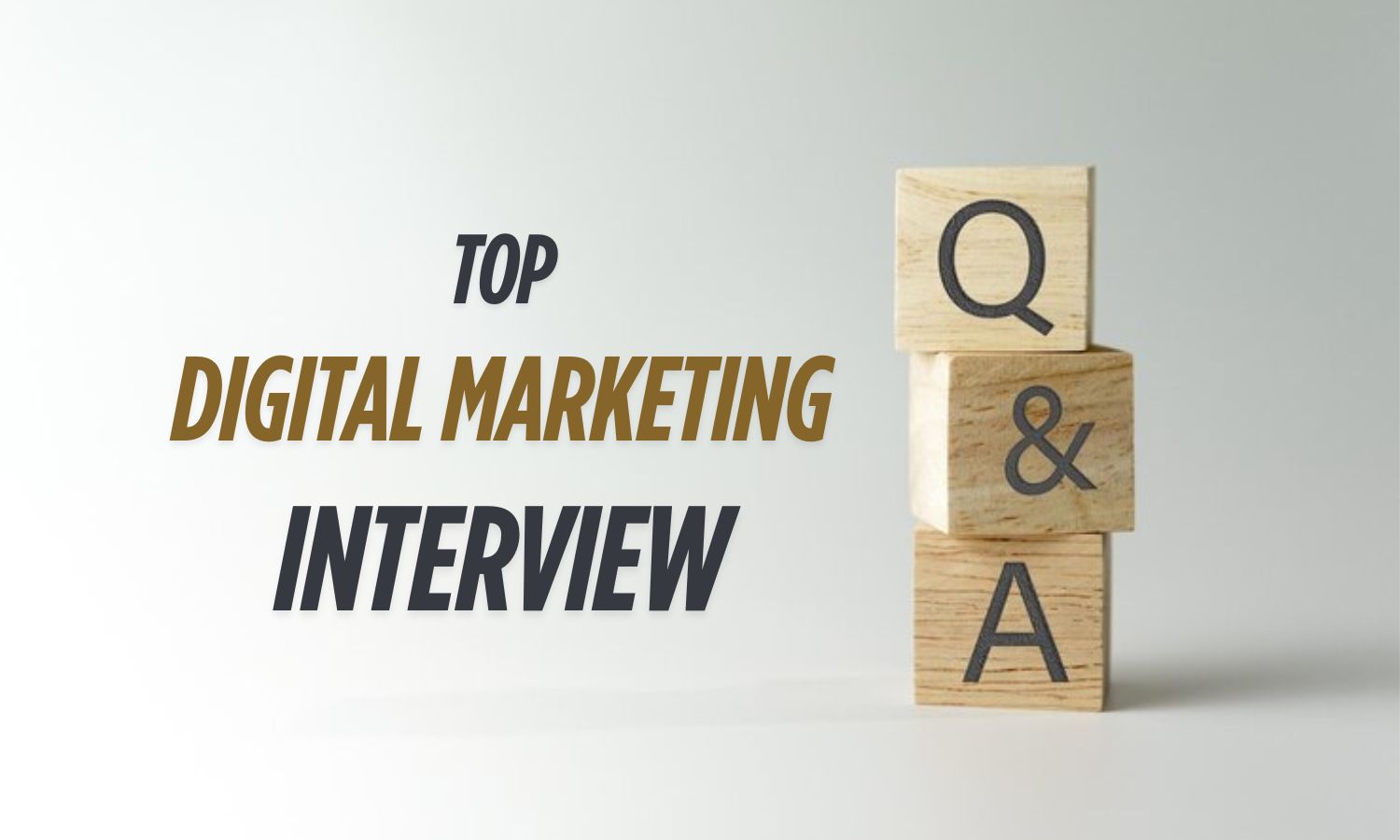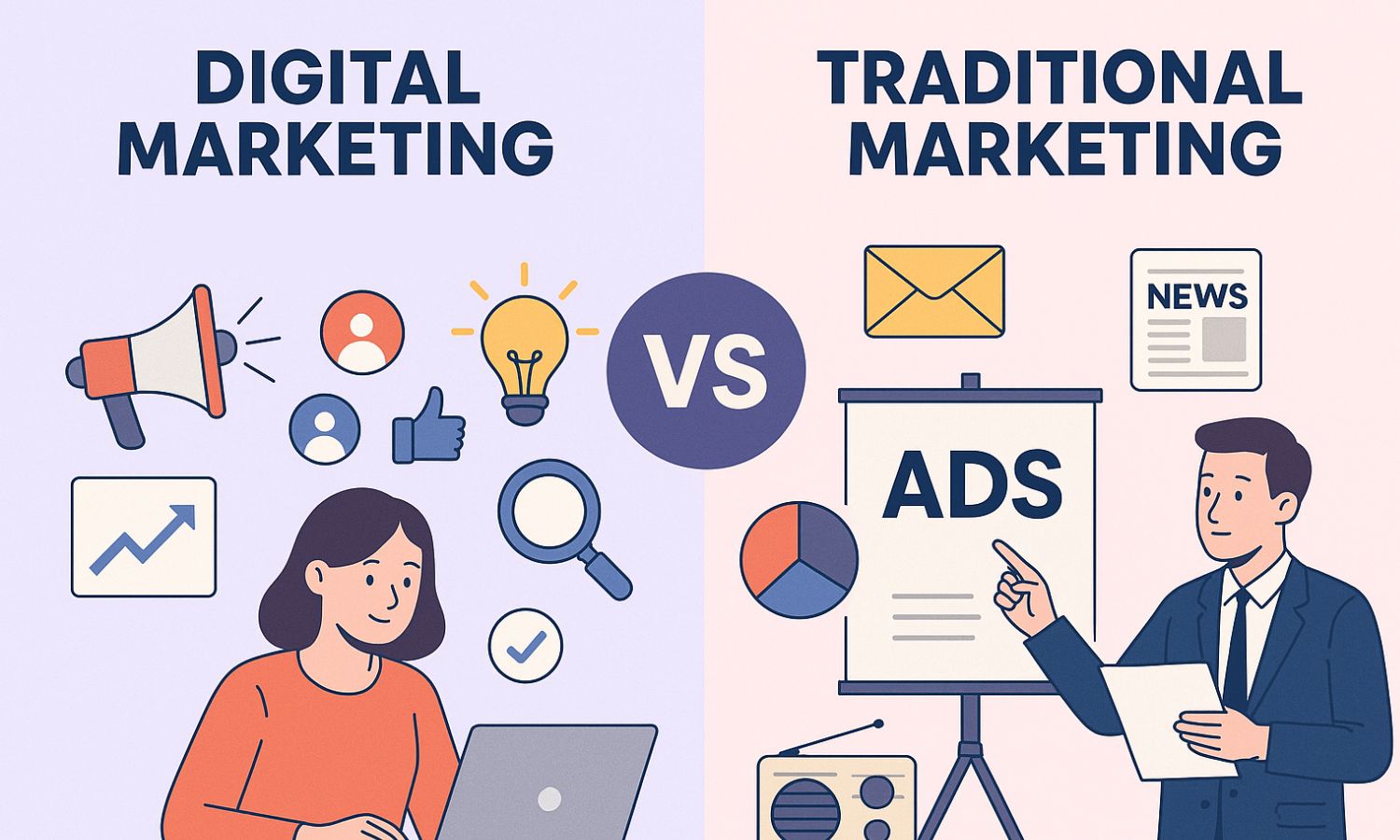The digital marketing landscape is a dynamic and ever-evolving field. As we move towards 2025, the demand for skilled digital marketers continues to soar. Landing your dream job in this exciting industry requires not only a strong understanding of core concepts but also the ability to articulate your knowledge and insights effectively during an interview. Whether you aspire to become a digital marketer, are a graduate of a digital marketing academy, or have completed an advanced digital marketing course in Jaipur (or elsewhere), this comprehensive Q&A guide will equip you with the knowledge and confidence to ace your next digital marketing interview.
This article covers a wide range of topics, from fundamental principles to emerging trends, providing you with insightful answers and key takeaways. We’ll delve into areas like SEO, PPC, social media marketing, content marketing, email marketing, analytics, and more. If you’re looking to kickstart your career or elevate your existing skills through learning and development or professional development training, understanding these interview questions is a crucial step. Even if you’ve focused on a specific area like SEO training in Jaipur or are looking to learn PPC marketing or understand the intricacies of a performance marketing course, a broad understanding of the digital marketing ecosystem is essential. This guide will also touch upon the importance of a training and development certification in validating your expertise.
I. Digital Marketing Fundamentals
Q1: What is digital marketing, and why is it important for businesses today?
A: Digital marketing encompasses all marketing efforts that utilize electronic devices or the internet. It’s crucial for businesses today because it allows them to reach a vast and targeted audience, build brand awareness, engage with customers directly, measure campaign performance accurately, and ultimately drive sales and growth in a cost-effective manner. Unlike traditional marketing, digital marketing offers real-time analytics and the ability to personalize marketing messages.
Q2: Can you explain the key components of a digital marketing strategy?
A: A robust digital marketing strategy typically includes:
- Search Engine Optimization (SEO): Optimizing website content to rank higher in search engine results pages (SERPs) for relevant keywords.
- Pay-Per-Click (PPC) Advertising: Running paid ad campaigns on search engines and social media platforms to drive targeted traffic.
- Social Media Marketing: Utilizing social media platforms to build brand presence, engage with audiences, and drive traffic and conversions.
- Content Marketing: Creating and distributing valuable, relevant, and consistent content to attract and retain a clearly defined audience.
- Email Marketing: Building and engaging with an email list to nurture leads, promote products or services, and build customer loyalty.
- Analytics and Measurement: Tracking and analyzing campaign performance using various tools to understand what’s working and identify areas for improvement.
- Mobile Marketing: Optimizing marketing efforts for mobile devices, considering the increasing use of smartphones and tablets.
Q3: What are some key performance indicators (KPIs) you would track for a digital marketing campaign?
A: The specific KPIs depend on the campaign goals, but some common and crucial ones include:
- Website Traffic: The number of visitors to a website.
- Conversion Rate: The percentage of visitors who complete a desired action (e.g., purchase, sign-up, download).
- Click-Through Rate (CTR): The percentage of people who click on an ad or link.
- Cost Per Acquisition (CPA): The cost of acquiring a new customer.
- Return on Investment (ROI): The profitability of a marketing campaign relative to its cost.
- Engagement Rate (Social Media): The level of interaction (likes, comments, shares) on social media posts.
- Bounce Rate: The percentage of visitors who leave a website after viewing only one page.
- Customer Lifetime Value (CLTV): The total revenue a customer is expected to generate over their relationship with a business.
II. Search Engine Optimization (SEO)
Q4: What is SEO, and what are the different types of SEO?
A: SEO (Search Engine Optimization) is the process of optimizing your website and its content to rank higher in organic (non-paid) search engine results pages (SERPs). The main types of SEO are:
- On-Page SEO: Optimizing elements within your website, such as content, keywords, meta descriptions, title tags, and internal linking.
- Off-Page SEO: Activities performed outside of your website to improve its authority and ranking, such as link building, social media marketing, and brand mentions.
- Technical SEO: Optimizing the technical aspects of your website, such as site speed, mobile-friendliness, site architecture, and schema markup, to make it easier for search engines to crawl and index.
Q5: What are some important factors for on-page SEO in 2025?
A: Key on-page SEO factors for 2025 include:
- High-Quality, Relevant Content: Creating valuable and engaging content that directly addresses user intent.
- Keyword Optimization: Strategically using relevant keywords in titles, headings, content, and meta descriptions.
- User Experience (UX): Ensuring a website is user-friendly, mobile-responsive, and has fast loading speeds.
- Compelling Title Tags and Meta Descriptions: Crafting engaging snippets that encourage clicks from SERPs.
- Internal Linking: Linking relevant pages within your website to improve site navigation and distribute link equity.
- Image Optimization: Using descriptive file names and alt text for images.
- Schema Markup: Implementing structured data to help search engines understand the content on your pages.
Q6: How would you approach link building for a new website?
A: For a new website, a strategic and ethical approach to link building is crucial:
- Create High-Quality Content: Valuable content naturally attracts backlinks.
- Guest Blogging: Writing articles for other relevant websites in your industry with a link back to your site.
- Broken Link Building: Identifying broken links on other websites and offering your content as a replacement.
- Resource Page Outreach: Finding resource pages in your niche and suggesting your relevant content for inclusion.
- Local Citations: Listing your business in relevant online directories.
- Social Media Promotion: Sharing your content on social media to increase visibility.
- Building Relationships: Networking with other website owners and influencers in your industry.
III. Pay-Per-Click (PPC) Marketing
Q7: What is PPC marketing, and what are its key benefits?
A: PPC (Pay-Per-Click) marketing is an online advertising model where advertisers pay a fee each time one of their ads is clicked. Key benefits include:
- Targeted Reach: Ability to target specific demographics, interests, and locations.
- Measurable Results: Detailed tracking of ad performance and ROI.
- Fast Results: Ability to drive traffic and conversions quickly.
- Budget Control: Setting daily or campaign budgets to manage spending.
- Flexibility: Ability to adjust campaigns and targeting in real-time.
If you want to learn PPC marketing effectively, understanding these benefits is a great starting point.
Q8: Explain the Google Ads auction process.
A: The Google Ads auction determines which ads appear and in what order on the search results page. It involves several factors:
- Bid Amount: The maximum amount an advertiser is willing to pay for a click.
- Quality Score: A rating assigned by Google based on the relevance and quality of your keywords, ads, and landing page.
- Ad Extensions: Additional information displayed with your ads, such as sitelink extensions or call extensions.
- Ad Rank: A value calculated by multiplying your bid amount by your Quality Score, with ad extensions and other factors also influencing it. Google uses Ad Rank to determine ad position.
Q9: What are some important PPC metrics you would monitor and why?
A: Key PPC metrics to monitor include:
- Impressions: The number of times your ad was shown.
- Clicks: The number of times your ad was clicked.
- Click-Through Rate (CTR): (Clicks / Impressions) – Indicates the relevance of your ads to the keywords.
- Cost Per Click (CPC): The average amount you pay for each click.
- Conversion Rate: The percentage of clicks that resulted in a desired action.
- Cost Per Acquisition (CPA): The cost of acquiring a new customer through your ads.
- Return on Ad Spend (ROAS): The revenue generated for every dollar spent on advertising.
Understanding these metrics is crucial for anyone taking a performance marketing course.
IV. Social Media Marketing
Q10: How would you develop a social media marketing strategy for a brand?
A: Developing a social media marketing strategy involves:
- Defining Goals: Identifying what you want to achieve (e.g., brand awareness, lead generation, customer engagement).
- Identifying Target Audience: Understanding who you are trying to reach on social media.
- Platform Selection: Choosing the social media platforms where your target audience is most active.
- Content Strategy: Planning the type of content you will create and share.
- Engagement Strategy: Outlining how you will interact with your audience.
- Measurement and Analysis: Tracking key metrics to evaluate performance and make adjustments.
- Paid Social Media Strategy: Determining if and how you will use paid advertising on social media.
Q11: What are some effective ways to increase engagement on social media?
A: Effective ways to boost social media engagement include:
- Creating High-Quality, Engaging Content: Sharing valuable, interesting, and visually appealing content.
- Asking Questions and Running Polls: Encouraging interaction and feedback.
- Responding to Comments and Messages Promptly: Showing that you value your audience.
- Running Contests and Giveaways: Incentivizing participation.
- Using Relevant Hashtags: Increasing discoverability.
- Going Live: Connecting with your audience in real-time.
- Collaborating with Influencers: Reaching new audiences through trusted voices.
V. Content Marketing
Q12: What is content marketing, and why is it important?
A: Content marketing is a strategic marketing approach focused on creating and distributing valuable, relevant, and consistent content to attract and retain a clearly defined audience — and, ultimately, to drive profitable customer action. It’s important because it builds trust and authority, attracts organic traffic, generates leads, nurtures customers, and supports overall marketing goals.
Q13: What are some different types of content you might create for a content marketing strategy?
A: A diverse content marketing strategy might include:
- Blog Posts: Informative and engaging articles on relevant topics.
- Ebooks and Whitepapers: In-depth guides and reports.
- Infographics: Visually appealing representations of data and information.
- Videos: Engaging visual content for education or entertainment.
- Podcasts: Audio content for on-the-go consumption.
- Case Studies: Demonstrating success stories and results.
- Webinars: Interactive online presentations.
- Social Media Posts: Engaging content tailored to specific platforms.
VI. Email Marketing
Q14: What are some best practices for building and managing an email list?
A: Best practices for email list building and management include:
- Offering Value: Providing incentives like free ebooks, discounts, or exclusive content for sign-ups.
- Making it Easy to Subscribe: Placing clear and visible sign-up forms on your website and social media.
- Segmenting Your List: Categorizing subscribers based on their interests and behavior.
- Obtaining Clear Consent: Ensuring subscribers opt-in to receive your emails (GDPR compliance).
- Cleaning Your List Regularly: Removing inactive subscribers to improve deliverability.
- Providing an Easy Way to Unsubscribe: Respecting subscriber preferences.
Q15: What are some key metrics you would track for an email marketing campaign?
A: Important email marketing metrics include:
- Open Rate: The percentage of subscribers who opened your email.
- Click-Through Rate (CTR): The percentage of subscribers who clicked on a link in your email.
- Conversion Rate: The percentage of subscribers who completed a desired action after clicking a link.
- Bounce Rate: The percentage of emails that could not be delivered.
- Unsubscribe Rate: The percentage of subscribers who opted out of your list.
- Return on Investment (ROI): The profitability of your email marketing efforts.
VII. Analytics and Measurement
Q16: Why is data analysis important in digital marketing?
A: Data analysis is crucial in digital marketing because it allows marketers to:
- Measure Campaign Performance: Understand what’s working and what’s not.
- Identify Trends and Insights: Discover patterns in customer behavior and market dynamics.
- Optimize Campaigns: Make data-driven decisions to improve results.
- Understand Customer Behavior: Gain insights into how users interact with your website and content.
- Demonstrate ROI: Prove the value of marketing efforts to stakeholders.
Q17: What are some essential digital marketing tools you are familiar with?
A: Familiarity with various digital marketing tools is a plus. Examples include:
- SEO Tools: Google Search Console, SEMrush, Ahrefs, Moz.
- PPC Tools: Google Ads, Microsoft Advertising.
- Social Media Management Tools: Hootsuite, Buffer, Sprout Social.
- Analytics Tools: Google Analytics, Adobe Analytics.
- Email Marketing Platforms: Mailchimp, Constant Contact, Sendinblue.
- Content Management Systems (CMS): WordPress, Drupal, Shopify.
VIII. Emerging Trends
Q18: What are some emerging trends in digital marketing that you find interesting for 2025?
A: Staying updated on emerging trends is vital. Some interesting trends for 2025 might include:
- Artificial Intelligence (AI) in Marketing: AI-powered personalization, chatbots, and predictive analytics.
- Personalized Marketing: Delivering tailored experiences based on individual customer data.
- Video Marketing: The continued rise of video content across platforms.
- Voice Search Optimization: Optimizing content for voice assistants.
- Augmented Reality (AR) and Virtual Reality (VR) in Marketing: Immersive brand experiences.
- Shoppable Content: Making it easier for consumers to purchase directly from content.
- Privacy-Focused Marketing: Adapting to increasing data privacy regulations.
Q19: How do you stay up-to-date with the latest trends and changes in digital marketing?
A: Staying current involves:
- Reading industry blogs and publications.
- Following thought leaders on social media.
- Attending webinars and conferences.
- Taking online courses and certifications.
- Experimenting with new tools and techniques.
- Networking with other digital marketing professionals.
IX. Behavioral and Situational Questions
Q20: Describe a successful digital marketing campaign you were involved in and your role.
A: We launched a social media campaign to introduce a new line of eco-friendly skincare products targeting millennials. My responsibility as the Social Media Marketing Manager was to create and implement a strategy that would build brand awareness and drive initial sales within this specific demographic. This involved in-depth audience research to identify their preferred platforms and content, leading us to focus on visually engaging content on Instagram and Pinterest. We collaborated with relevant micro-influencers in the sustainability space, ran targeted ad campaigns showcasing the product’s natural ingredients and ethical sourcing, and implemented interactive Instagram Stories and a user-generated content contest to boost engagement and drive traffic to the product landing page.
Q21: How do you handle a situation where a digital marketing campaign is not performing as expected?
A: When a digital marketing campaign underperforms, my first step is to conduct a thorough analysis of the available data. This involves examining key metrics like open rates, click-through rates, conversion rates, and website traffic to pinpoint where the drop-off is occurring. Based on this analysis, I then brainstorm potential reasons for the underperformance, considering factors such as targeting accuracy, ad creative relevance, landing page experience, and even technical issues. Once potential issues are identified, I develop a range of solutions, prioritizing those that can be implemented and tested quickly.
Q22: How do you prioritize tasks and manage your time in a fast-paced digital marketing environment?
A: I typically begin by gaining a clear understanding of the overarching marketing goals and the potential impact of each task on achieving those objectives. I often utilize a system, whether it’s a digital project management tool or a prioritized to-do list, to keep track of all ongoing projects and deadlines. I break down larger projects into smaller, more manageable steps and allocate specific time slots for focused work on each. Regularly reviewing priorities and remaining flexible to adapt to shifting deadlines or urgent requests is also essential.
Conclusion
Preparing for a digital marketing interview in 2025 requires a solid grasp of core principles, current trends, and the ability to clearly articulate your skills. Reviewing common questions and crafting thoughtful answers will significantly enhance your preparedness to showcase your expertise and secure a role in this dynamic field. Whether your foundation comes from a digital marketing academy, an advanced course in Jaipur, or ongoing professional development skills, your passion and demonstrated understanding are key. For aspiring digital marketers, especially IT professionals transitioning careers, a strong grasp of these concepts is essential.
Ready to advance your digital marketing career? Consider IT BY IT Professionals for a complete digital marketing training course tailored to your needs. We recognize the unique strengths IT professionals bring and have designed a curriculum integrating your technical skills with cutting-edge marketing strategies. Our advanced course, accessible in Jaipur, goes beyond basics, exploring AI-powered marketing, immersive tech, and data-driven decisions.
Why IT BY IT Professionals? We offer hands-on experience, real-world case studies, and insights into the 2025 digital landscape, empowering you to implement impactful strategies and become a highly desirable candidate. For IT professionals seeking a fulfilling career shift, our complete course is your ideal springboard. Embrace the future of marketing with IT BY IT Professionals and unlock your potential. Best of luck!






